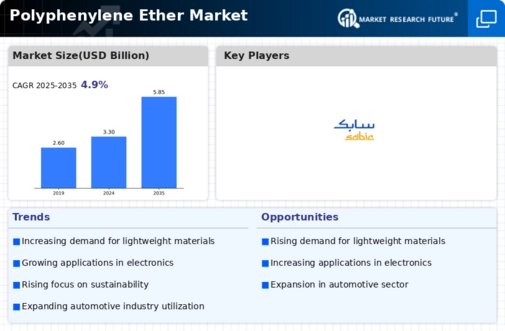Market Analysis
In-depth Analysis of Polyphenylene Ether PPE Market Industry Landscape
The polyphenylene ether (PPE) market is characterized by dynamic forces that shape its growth, demand, and supply. Market dynamics within this sector are influenced by various factors, including technological advancements, shifting consumer preferences, regulatory policies, and economic conditions. One significant driver of market dynamics in the PPE industry is the growing demand from end-use sectors such as automotive, electronics, and construction. These sectors rely on PPE due to its exceptional properties, including high heat resistance, flame retardancy, and mechanical strength.
PPE is being increasingly used in numerous applications such as electrical and electronic, automotive, healthcare, and home appliances on account of superior properties such as flame retardant, high stiffness, hydrolytic stability, and excellent dimensional stability.
Technological advancements play a crucial role in shaping the dynamics of the PPE market. Ongoing research and development efforts aim to enhance the performance characteristics of PPE materials, expanding their application scope and market potential. Additionally, innovations in manufacturing processes contribute to increased production efficiency and cost-effectiveness, thereby influencing market dynamics by altering supply chains and pricing structures.
Consumer preferences also influence the dynamics of the PPE market. As awareness of environmental issues grows, there is a rising demand for sustainable and eco-friendly materials. Manufacturers are responding to this trend by developing bio-based and recyclable PPE formulations, thereby reshaping market dynamics and driving competition in the industry. Moreover, changing consumer lifestyles and preferences for lightweight, durable products drive the demand for PPE in various applications, further influencing market dynamics.
Regulatory policies and standards play a critical role in shaping the dynamics of the PPE market. Government regulations regarding product safety, environmental impact, and recycling requirements impact manufacturing processes, product formulations, and market access. Compliance with these regulations is essential for companies operating in the PPE industry, as non-compliance can lead to penalties, reputational damage, and loss of market share. Consequently, regulatory dynamics influence investment decisions, product development strategies, and market competitiveness within the PPE sector.
Economic conditions also impact the dynamics of the PPE market. Fluctuations in macroeconomic indicators such as GDP growth, inflation rates, and exchange rates influence consumer purchasing power, industrial production levels, and investment sentiment. Economic downturns can lead to reduced demand for PPE products as industries cut costs and scale back operations, whereas periods of economic expansion typically stimulate market growth and investment activity. Consequently, market players within the PPE industry must monitor economic trends and adapt their strategies accordingly to navigate changing market dynamics effectively.
Furthermore, the competitive landscape significantly influences the dynamics of the PPE market. Intense competition among key players drives innovation, pricing strategies, and market expansion initiatives. Mergers, acquisitions, and strategic partnerships are common in the PPE industry as companies seek to enhance their market position, expand their product portfolios, and leverage synergies to gain a competitive advantage. Additionally, the emergence of new entrants and disruptive technologies further intensifies competition, contributing to dynamic market conditions within the PPE sector.




Leave a Comment